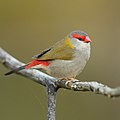| Neochmia | |
|---|---|
 | |
| Red-browed finch (Neochmia temporalis) | |
| Scientific classification | |
| Kingdom: | Animalia |
| Phylum: | Chordata |
| Class: | Aves |
| Order: | Passeriformes |
| Family: | Estrildidae |
| Genus: | Neochmia G.R. Gray, 1849 |
| Type species | |
| Fringilla phaeton | |
| Species | |
N. temporalis | |
Neochmia is a genus of estrildid finches found in Australasia. They are gregarious seed-eaters with short, thick, but pointed bills.

